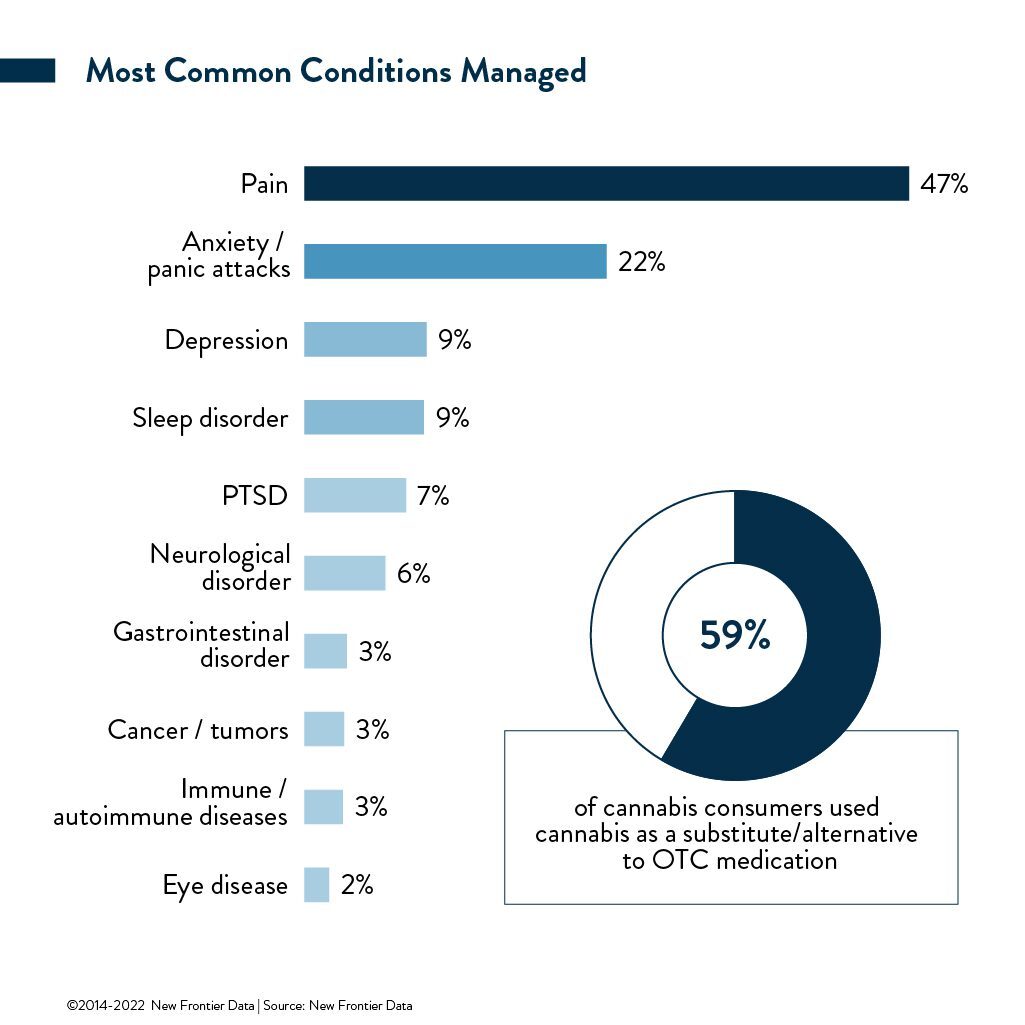Providing a Prescription for Meeting the Needs of Medical Cannabis Patients

An Overdue Prescription for Appreciating Medical Cannabis
December 15, 2022
Necessity vs. Nicety: Adult-use and medical patient spending during tough economic times
January 10, 2023By Dr. Amanda Reiman (Ph.D., MSW), Chief Knowledge Officer, New Frontier Data
While governmental prohibition of cannabis as a dangerous, illicit narcotic spanned across several decades, its traditional use in medicine has existed for millennia. No wonder that the medical benefits of cannabis helped to break through barriers of prohibition, regain medicinal legitimacy, and spawn our globally expanding industry today.
That said, we still need to get some fundamental facts straight. Millions rely on cannabis for their physical and mental health. Though the numbers of official medical cannabis patients in a given state reliably decrease after full-fledged legalization of the plant, there remain significant numbers of consumers who keep using it for medical purposes. Too often, patient groups are kept from using health insurance or other benefits to cover or defray the cost of their medicine. For their parts, brands and retailers are challenged to find ways to meet patients’ needs despite restrictions about even discussing actual medical benefits with them, and doctors are often insufficiently informed about cannabis medicine, creating a void of information between all parties.
New Frontier Data’s latest brief, From Doctor to Dispensary: A Complete Picture of Medical Cannabis Consumers leverages data from our comprehensive 2022 Consumer Survey to summarize medical consumers’ motivations and cannabis use behaviors. By sharing how cannabis interacts with patients’ other medical regimes, consumption behaviors, and preferred products, our aim is to help insurance companies, brands, and retailers better understand and address the demographics of their primary and occasional customers. To get a handle on the wants and needs of medical patients, download a free copy.
Key findings from the report:
- Brands and marketers may make incorrect assumptions differentiating between medical and recreational cannabis consumers.
- Retailers should provide education-focused information on their menus, and promote product stability when serving medical consumers.
- Insurance companies should anticipate providing for patients’ use of medical cannabis as they do for other health-related prescriptions, treatments, or therapies.
- Medical consumer behaviors like the use of cannabis as a substitute for prescription and over the counter medications are useful for insurance companies in evaluating long term reductions in harm.
Popular support for legalization of cannabis is overwhelming among U.S. adults, as confirmed by the Pew Research Center. Its latest survey (conducted in October) found 88% approval among respondents saying either that marijuana should be legal for medical and recreational use by adults (59%), or that it should be legal for medical use only (30%). Only 1 in 10 (10%) wanted marijuana to remain illegal. Those levels remain virtually unchanged since April 2021.
Even among self-identifying Republicans (which as a group has traditionally been more conservative than other American voters about supporting cannabis), wide majorities across all age groups favor legalizing marijuana for medical use: According to Pew’s research, even among Republicans 65 and older, just 17% say that marijuana use should not be legal even for medical purposes.
Earlier this month, President Joe Biden signed the Medical Marijuana and Cannabidiol Research Expansion Act, to establish “a new registration process for conducting research on marijuana and for manufacturing marijuana products for research purposes and drug development.”
In short, the law accelerates the application process to approve marijuana-related scientific studies, and scientists will be at liberty to access sufficient amounts of cannabis to conduct research for learning more about the plant’s medical properties.
This month, the oldest medical cannabis patient advocacy organization, Americans for Safe Access, celebrated their 20th anniversary. And even though there has been a shift in both policy and attitudes around medical cannabis since the group’s inception, Founder Steph Sherer notes the work still to be done. “Medical cannabis patients and adult-use consumers have very different needs”, she reminded. “Medical cannabis patients are looking for consistency, availability, and affordability above all. Patients are paying out-of-pocket for their medicine, and can’t afford to experiment each time they go to a dispensary. When a patient finally finds a product that works for them, it is a major setback to their health when that product is crowded out by adult-use-facing products. Furthermore, patients need a larger variety of cannabinoid and terpene contents in their medical needs.”
Access more comprehensive, in-depth activity and analysis about the medical cannabis market with, New Frontier Data’s business intelligence platform. View our complete library of analyst reports and webinars, check activity on a localized, state-by-state basis, and review our five dashboards of interactive cannabis data widgets connecting you to best-in-class retail, consumer, and market intelligence.




